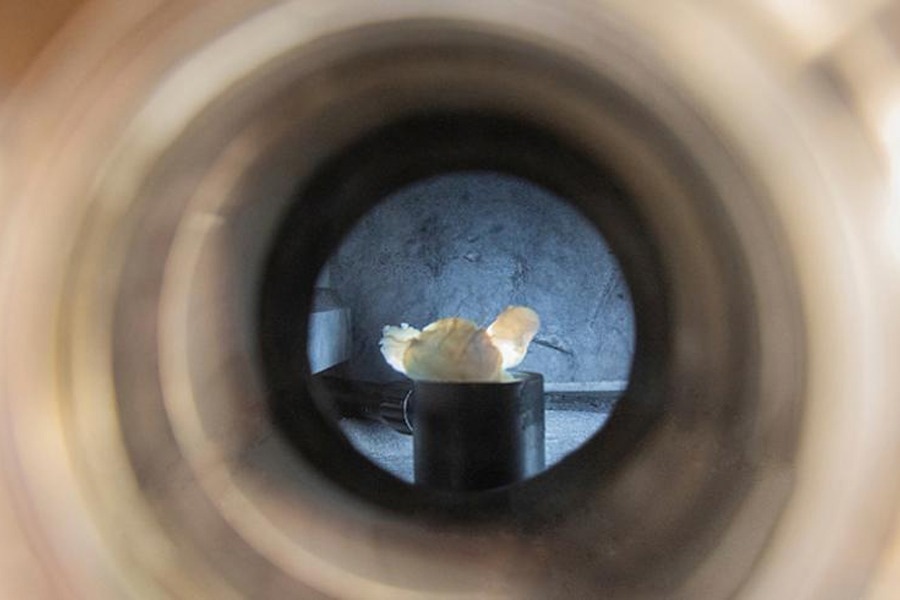At the High-Performance Materials Institute, a group of FAMU-FSU College of engineering scientists is examining the thermal limits of advanced nanomaterials. This is work that could have an immediate impact on electronics, medicine delivery systems, space travel, and other applications.

Boron nitride nanotube material in a crucible for heating at Florida State University’s High-Performance Materials Institute. Image Credit: Mark Wallheiser/FAMU-FSU Engineering
The research group, headed by Assistant Professor in Industrial and Manufacturing Engineering Rebekah Sweat, finished the first-ever study on how purified boron nitride nanotubes tend to remain stable in extreme temperatures in inert surroundings.
Their study was reported in the Applied Nano Materials journal.
Compared to carbon nanotubes, boron nitride nanotubes, or also-called BNNTs, are more powerful and highly resistant to high temperatures. Similar to their carbon cousins, they are structures quantified by the nm—a length equal to one-billionth of a meter.
However, manufacturing such materials is difficult. Current techniques are relatively new and do not yet generate the same quantities as techniques devised for carbon nanotubes. That is why learning more about how they function is significant.
The scientists discovered that BNNTs are completely stable at up to 1800 °C in an inert surroundings like the chemically inactive air in which they have been manufactured. They learned that BNNTs have the potential to resist temperatures ranging up to 2200 °C for short periods without missing the mechanical properties that make them highly effective.
This research is about uncovering a property that is incredibly useful for the future. We have a more robust knowledge of how BNNTs perform when and how they thermally fail – because all materials do have limitations. We have changed how we make these types of composites to better utilize their properties.
Rebekah Sweat, Assistant Professor, Industrial and Manufacturing Engineering, Florida State University
Likely applications for such light and powerful composite materials are countless. Any material that gets hot, similar to an engine or turbine, may utilize them to serve in a high-temperature surrounding. They are thermally conducting, implying they spread heat out in a rapid manner, and their mechanical stability provides structural reinforcement.
In space exploration, BNNTs show specific promise. They could insulate electrical current and further block radiation that could be utilized in space rovers or spacecraft at the time of the re-entry to Earth’s atmosphere. Those same properties make them beneficial for high-performance electronics.
Understanding the behavior of these nanotubes at high temperatures is crucial for creating materials that can withstand extreme conditions, both in manufacturing and in their final use.
Mehul Tank, Study Lead Author and Doctoral Student, Florida State University
Tank added, “As we understand better how they function in these conditions, we’ll be able to develop better manufacturing of composites that employ high-temperature processing matrices, like ceramics and metals.”
This study was financially supported in part by a grant earned from FSU’s GAP Commercialization Investment Program, an event that has been organized by the Office of Commercialization to help change academic research into possible commercial projects.
The financial support that Sweat received in 2022 through the Office of Commercialization’s competitive application process assisted the phase of this work that revealed the processing temperatures for BNNT-ceramic matrix composites that are known to be the center of the GAP project.
Together with the GAP funding, this study was also assisted via a collaboration with the Virginia-based company BNNT Materials. The company synthesized BNNTs and collaborated with Florida State University scientists to disclose how the nanotubes survived high temperatures and how different chemistries will be executed.
GAP has helped my team explore new avenues and encouraged collaboration to move this work further. The application process and emphasis on translating research from the lab to materials that are relevant for industry helps focus our research on exciting emerging technologies.
Rebekah Sweat, Assistant Professor, Industrial and Manufacturing Engineering, Florida State University
Contribution to the study was given by scientists Aspen Reyes, Jin Gyu Park, and Ana De Leon from the FAMU-FSU College of Engineering, and Lyndsey Scammell and Michael Smith from BNNT Materials.
Journal Reference:
Tank, M. J., et al. (2022) Extreme Thermal Stability and Dissociation Mechanisms of Purified Boron Nitride Nanotubes: Implications for High-Temperature Nanocomposites. ACS Applied Nano Materials. doi.org/10.1021/acsanm.2c01965.